Zotac's Ion: The World's First mini-ITX Ion Board
by Anand Lal Shimpi on May 12, 2009 12:00 AM EST- Posted in
- GPUs
SYSMark 2007 Performance
Our journey starts with SYSMark 2007, the only all-encompassing performance suite in our review today. The idea here is simple: one benchmark to indicate the overall performance of your machine.
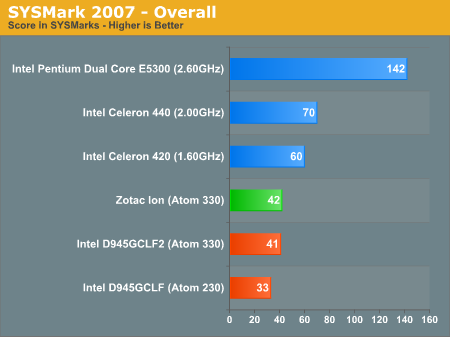
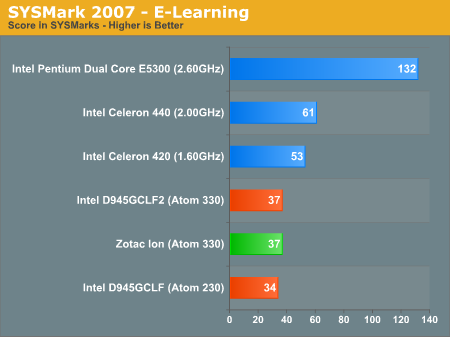

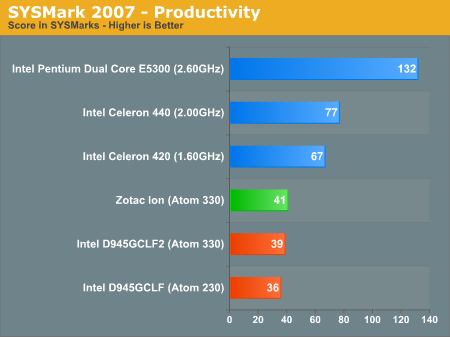
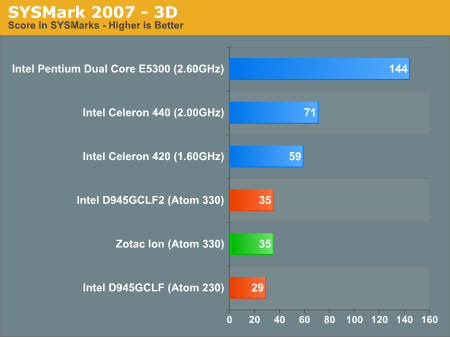
There's a 27% performance improvement realized in SYSMark 2007 when going from the single-core Atom 230 to the dual-core Atom 330. Even the Atom 330 is outperformed by the lowest end Celeron 420 by 43% however.
Note that in general application usage there's no significant performance difference between the Zotac Ion and the Intel D945GCLF2.
And before you get any ideas of replacing a modern day, low-end system with an Ion look at the E5300 score. The E5300 offers 3.4x the speed of the Atom 330. Granted you need a more expensive motherboard but compared to the Zotac Ion, it's not that much more expensive.
Adobe Photoshop CS4 Performance
To measure performance under Photoshop CS4 we turn to the Retouch Artists’ Speed Test. The test does basic photo editing; there are a couple of color space conversions, many layer creations, color curve adjustment, image and canvas size adjustment, unsharp mask, and finally a gaussian blur performed on the entire image.
The whole process is timed and thanks to the use of Intel's X25-M SSD as our test bed hard drive, performance is far more predictable than back when we used to test on mechanical disks.
Time is reported in seconds and the lower numbers mean better performance. The test is multithreaded and can hit all four cores in a quad-core machine.
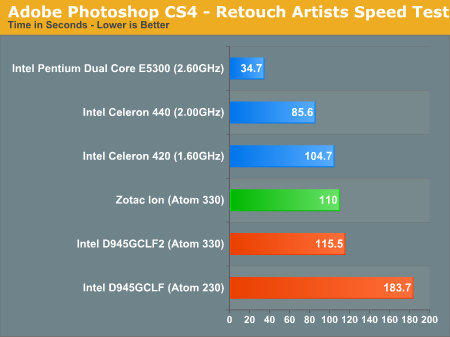
This test was particularly surprising, because with four threads the Atom 330 is able to actually come within striking distance of the Celeron 420's performance - at a considerably lower power consumption. Once we transition to an even more multi-threaded environment where multi-core processors can always maintain a significant performance advantage over their single core brethren then it may be more efficient to toss a few Atom-cores at a problem than something like the Celeron 420. Hmm, perhaps Larrabee will be more useful than we thought...
The single-core Atom 230 is horrendously slow in this test. While the 330 could masquerade as a very low end microprocessor from the modern era, the 230 takes significantly longer to complete our test. No thanks.
The difference between Ion and the D945GCLF2 is negligible.










93 Comments
View All Comments
nubie - Tuesday, May 12, 2009 - link
Assuming the price is under $180 for the LGA 775 board that would be my choice.You can passively cool a Celeron 420, 430 or 440 and pick one up for $25-30 on ebay. The Conroe-L will absolutely murder the Atom for any gaming or encoding, and most of them will bump to 1066 without a voltage increase.
The 775 board is $139 with free shipping.
http://www.newegg.com/Product/Product.aspx?Item=N8...">http://www.newegg.com/Product/Product.aspx?Item=N8...
Throw an e5200 or Celeron DualCore at it and just laugh at the Ion platform trying to keep up.
Don't forget the PCI-e 2.0 x16 slot so you can game too if you want.
My choice is pretty clear, forget ION for the desktop unless you really need one of the features (DC power, ultra-low consumption, just can't afford the extra $20-40) the LGA 775 is the better choice for future-proofing an ITX platform. And chances are you have the CPU and heatsink laying around (I know I do.)
If they can get a 32nm Desktop processor at 15-20 watts (for the CPU) instead of that Atom I would love to see it.
strikeback03 - Wednesday, May 13, 2009 - link
I'm not sure I would call anything on LGA 775 future-proofing, as all the processors we are going to see for that socket are now out. So yes performance would be better than Ion, but it would still be a system with almost no room to upgrade.nubie - Thursday, May 14, 2009 - link
I meant future-proofing as in "allowing the platform to remain viable into the foreseeable future." And in comparison with the Atom board it is infinitely future-proof (X16 PCI-e 2.0 and an LGA socket will do that.)You can't argue that a 3.0ghz Quad core won't work adequately for the next 5 years on any conceivable OS, whereas this Atom processor is struggling even now.
Not to mention the PCI-e 2.0 x16 slot, what happens when the 9300 doesn't cut it anymore? The Atom platform has no room for upgrade.
If they cost the same when you outfit the LGA 775 motherboard with a Celeron (and the celeron is much faster), with the option down the road of a dual or quad core and any video card you want, I would say in comparison to the Atom board it is future-proofing.
strikeback03 - Thursday, May 14, 2009 - link
If power consumption is a concern though, you won't ever be using a Penryn quad-core. Due to the memory controller it is highly unlikely any motherboards from the Penryn era will be usable with future processors, so for low power usage an Atom board now and something else low power in a year or two is more likely the way to go.dEad0r - Tuesday, May 12, 2009 - link
Why are there different versions of that platform?Today Computerbase released their review of the "Zotac IONITX-A", which features the same CPU, but offers the faster Nvidia 9400 graphics card onboard.
So all the gaming benchmarks should be way better.
http://www.computerbase.de/artikel/hardware/mainbo...">http://www.computerbase.de/artikel/hard...dia_ion/...
As you can see, for World in Conflict, Doom 3, F.E.A.R. and Company of Heroes are fully playable at 1024x768 1xAA/1xAF, as the ION gives us ~30 fps in those tests.
JarredWalton - Tuesday, May 12, 2009 - link
Don't get too carried away: the 9400 runs at 580/1400MHz core/shader clocks while the 9300 runs at 450/1200MHz core/shader clocks. Assuming games aren't bottlenecked by memory bandwidth, the 9400 is about 20% faster - so it could equal the X800 XT.Those benchmarks you link show the GeForce 9400 as being around six times faster than the 945G chipset, which is quite similar to the results Anand shows in WoW. I'm guessing that the details are set to low or medium in order to get many of those games to 5-6FPS with the GMA 950.
Pirks - Tuesday, May 12, 2009 - link
when you have this: http://www.newegg.com/Product/Product.aspx?Item=N8...">http://www.newegg.com/Product/Product.aspx?Item=N8...sprockkets - Tuesday, May 12, 2009 - link
Because that board is crap compared to the Intel LGA board in the article.It lacks a x16 pci-e slot, wifi isn't built in, needs laptop ram and has no optical or coax audio out. Plus, Linux easily supports PureVideo; no such tech I know of for Ati. While this does feature more SATA ports, I can live without that.
And you rather pay $20 more for that?
Visual - Wednesday, May 13, 2009 - link
dude, the atom mini itx boards also don't have pci-express 16x. intels have a pci just like this amd, the ion one has mini-pci-e which is just 1x and it is ment to be used with the bundled wireless card - it will be quite hard to find other devices for it.where did you get that 16x from?
sprockkets - Thursday, May 14, 2009 - link
Are you capable of looking at the specs yourself of the LGA board in the article?Or, look here: http://www.newegg.com/Product/Product.aspx?Item=N8...">http://www.newegg.com/Product/Product.aspx?Item=N8...
I accept your apology Pirks.